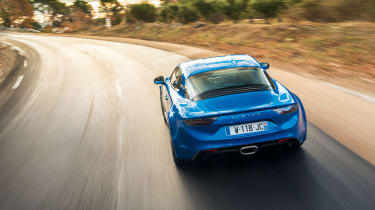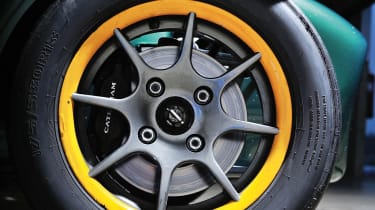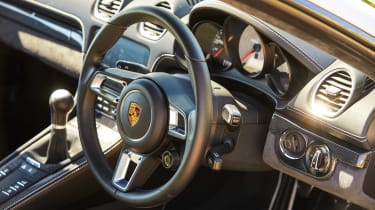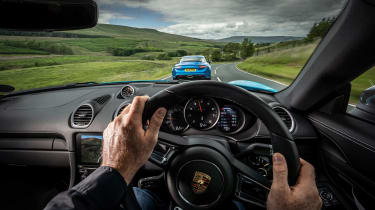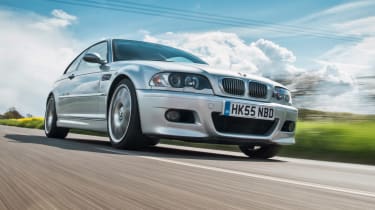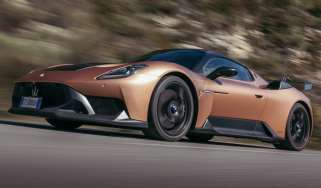What makes the perfect sports car?
From Alpines to Lotuses via Porsches and TVRs, so many sports cars have thrilled us, yet they don’t all follow the same recipe. So what exactly are the essential ingredients for making a perfect sports car? Seven evo writers reveal what they look for
How do you make the perfect sports car? It's something that we posed to seven of our writers to establish what, and how certain elements fulfil the brief of creating something designed purely to elicit a smile down a twisting road. But the business figuring out what appeals of course changes person to person, so it’s not as simple as following a single recipe to success for the modern sports car. To form some level of consensus about the elements all sports cars should inhabit, we asked seven of our writers what appeals to them most.
Stuart Gallagher
Size. The killer ingredient when it comes to the perfect sports car. An engine’s power output, a chassis’ balance, the steering’s feedback or how easily the brakes can be modulated are all important, but they’re all redundant if you spend your time trying to keep the car within the confines of a road’s white lines.
Get the footprint right and all of the above drop into place: enough power to work the chassis but not overwhelm it, precision from the steering, reassurance from the brakes and the crispest of the gearshifts (yes, it’s a manual), combined with a weight that’s in proportion to all of the above. Performance isn’t paramount but involvement and enjoyment are, because a good sports car is as engaging and enjoyable at 50 per cent of its capability as it is thrilling and rewarding at 100. Who does it best? For me that’s Alpine (A110), Lotus (Elise) and Porsche (Boxster/Cayman).
John Barker
A sports car should exist to be driven, so it’s all about connection, character and dynamic reward. Front engine, rear-drive for uncomplicated handling, a naturally aspirated unit giving a solid power-to-weight ratio of 250bhp per ton, that weight around 1000kg, though less is always more. Not stripped to the bone; it needs to be comfortable, but doesn’t need all modern comforts and conveniences.
Grip (tyre size) determined by the torque of the engine, the balance just in the engine’s favour, that torque delivered via a sweet-shifting manual gearbox and a limited-slip differential. Importantly, an engine that’s brimming with character, so a triple, straight-six or V8, maybe a fab four, set well back in a car that’s modest in scale – no bigger than a Nissan 370Z. Crucially, the car should be engaging when ambling as well as when attacking a great road, and that’s down to having tactile primary controls and an engine with aural character.
I expect where I diverge from the classic interpretation of a sports car is that I don’t think it needs to be a convertible. Some lightweight sports cars such as the Caterham Seven are soft-top because a fixed roof needs proper doors, and they’re tricky to engineer, are costly and add weight. I sometimes enjoy the open air but a closed-roof car is stiffer, and that’s a permanent benefit. I think they’re more handsome, too. I give you E-type, F-type, Daytona, GT6, DB5, Z4 M…
Richard Meaden
There are many takes on the sports car recipe, but to my mind few truly hit the bullseye. I think that’s because I’m British and a purist at heart, but also because in my experience the most impressive driving experiences and most enduring appeal come from cars that possess a rare and very particular combination of qualities.
My perfect sports car is light and compact; no larger or more powerful than strictly necessary. Modest, even. It must be rear-wheel drive, but the engine can be up front, squeezed amidships or slung out back. The car should be pared back, most likely open-topped with two seats. Preferably pretty, too.
Unsurprisingly, it places an emphasis on driving finesse, though ultimately it should reward and inspire rather than relentlessly intimidate. It should be deft and communicative, the layers peeled back so that you feel the road through steering wheel and seat squab. It will make any road feel special because it makes no concession to average or ordinary, yet it never tries too hard.
What is this car? The Mk1 Lotus Elise, for I still don’t believe it will be surpassed. I could also be describing a raft of different Caterham Sevens, the last-gen Toyota MR2 and any generation of Mazda MX‑5. An honourable mention too for the many big-hearted TVRs – the Griffith in particular – of the Wheeler era. All are very different characters, yet exceptional in their own way. Refreshingly, they are eminently affordable, too. In a market obsessed with excessive power, unusable performance and unfathomable price tags, they are a salutary reminder that when brilliantly executed there are few better things than a truly great sports car.
David Vivian
MX-5? No. And it isn’t because it’s not fast enough. That’s the great myth. The kind of acceleration that stretches your mouth into a slightly terrified rictus has its place, but not necessarily in a sports car. The way I see it, huge horsepower can be a distraction. It seems almost stupidly obvious, but ‘sport’ is the thing and there’s more of it to be had in preserving momentum than hanging on for dear life.
That said, I don’t want a car where any sense of jeopardy is subsumed by a chassis so benign and forgiving that it teaches you no lessons and leaves you not quite sure if you’ve made a mistake or possess skills handed down from the gods. That’s why the MX-5 isn’t a sports car. It has all the right ingredients, but it’s too nice, too cushioned and too flattering.
Fun? Superficially, but that only takes you so far. My ideal sports car has sharper reflexes, an edginess to keep me on my toes. I don’t mind that. I want directness and connection that place the onus on me to get things right rather than having to operate in a prescriptive tight jacket. Points of interaction – steering, gearchange, clutch, brakes – should brim with unvarnished tactility and be harmoniously weighted, the seat shaped, padded and located to provide a further stream of feedback. You probably know where this is heading. A Caterham Seven pretty much nails it.
Henry Catchpole
A sports car is where the engineers get their way and the marketing department doesn’t. Ease of parking isn’t allowed to affect the weight and feel of steering at speed. Boot space is secondary in importance to the placement of suspension hard points. Wheel size is determined by ride and handling, not an aesthetic trend. Noise, vibration and harshness (or NVH) are not considered completely unacceptable. Mass and its management – both in terms of quantity and distribution – will be the fulcrum of decisions.
But neither should a sports car be a slave to numbers. It must have soul. And this most intangible of traits will materialise through the engineering rather than being engineered in. It might manifest itself principally in sound or handling or speed, or it might come to life through some slightly ethereal, alchemic mixture of multiple disparate physical assets. But however it is achieved, it will become clear through the thrill instilled in the occupants when it is being driven.
Jethro Bovingdon
Defining the perfect sports car could be a pretty simple job: two seats, two-doors, low mass, convertible, rear-wheel drive, rorty normally aspirated engine and a manual gearbox. But for me it’s never been quite that straightforward. It isn’t about defined ingredients, but rather the end result. The driving experience is everything.
In one way that’s great, because whilst a TVR Griffith qualifies, so might a Nissan GT-R, a BMW M3 or even a Renault Clio Trophy. I don’t care what it looks like, which wheels are driven, if the engine has a turbo or two. What I’m looking for isn’t easy to define absolutely, but it comes down to that magical place where driver demands, chassis response and powertrain capability all merge. Where request and reaction seem completely connected.
The things that make this loose, slightly soupy definition possible include steering feel, throttle response and chassis balance, but even then each great sports car might have vastly different helpings of each to reach the end goal. An Elise, for example, has wonderful steering feel, but its balance generally doesn’t have the adjustability I crave. Weirdly, something heavier, less pure and more reliant on technology might beat it in this respect. A Mitsubishi Evo, for example.
The crux of it is this. My perfect sports car does what I want it to at the precise moment I make the request. It involves me intimately in the way it flows down the road or around a track through throttle, steering and braking inputs. It allows me to drive it on the limit with no surprises thanks to clear feedback. It’s sharp, precise, forgiving at the limit and preferably has an engine that revs to 9000rpm or so. A lifetime supply of free tyres would be a nice bonus, too.
Adam Towler
It would be easy to write an entire dissertation on what makes a great sports car, and I don’t doubt that it’s possible to quantify no end of numerical values to illustrate a particularly essential attribute. But beyond that, I think a great sports car has to make you want to really drive. The wonderful thing about this is that if it has that golden knack then any journey can be a great drive, or even a real adventure, however mundane or slow.
And like so many magical propositions, what appears deceptively simple is actually fiendishly complicated: a mutating matrix of power-to-weight, overall dimensions, engine response, sound, driving position, control feedback and so on, entwined and then mixed together by brilliant engineers who, crucially, are allowed to put their own personal stamp on the car. Great cars come from great people, or great teams – that’s no coincidence.

